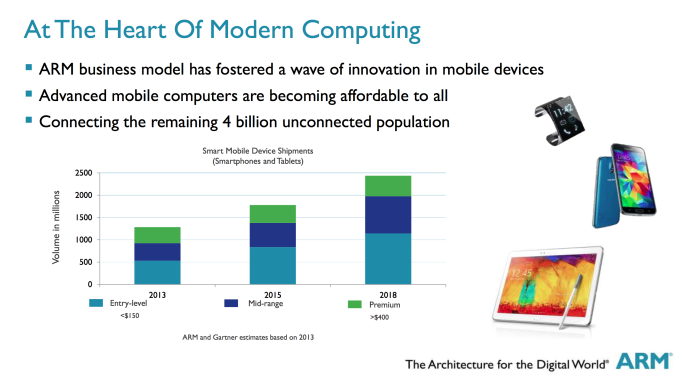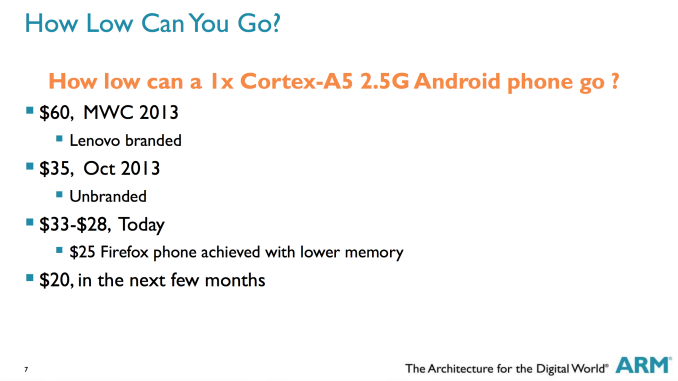ARM Expects ~1B Entry Level Smartphones in 2018, $20 Smartphones Coming This Year
by Anand Lal Shimpi on May 6, 2014 8:00 AM EST- Posted in
- Smartphones
- Arm
- Mobile
- SoCs

When we first started covering mobile, nearly every silicon vendor I spoke with issued the same statement: eventually, all phones are smartphones. Continued scaling on process technology, combined continued development of small/power efficient CPU cores, will ensure that even the lowest cost mobile devices will be smartphones.
At its second ever Tech Day, ARM shared some data about how the smartphone market is evolving. We often mention that the growth in the smartphone industry will shift from high-end devices to mid-range and entry level devices. The graph above shows just that. By 2018 ARM expects over a billion entry level (< $150) smartphone shipments per year, around 2x what it is today.
Two factors will drive entry level shipments: the performance of entry-level devices, and their overall cost. ARM believes the floor for an entry level smartphone running Android (today with a single-core Cortex A5 based SoC) is $20, and that we'll see the first devices on sale at that price point in the next few months. Manufacturing limits will likely prevent cost scaling below $20. Keep in mind that a single Cortex A5 is faster than the ARM11 in the original iPhone, which retailed for $599 in 2007.











31 Comments
View All Comments
Murloc - Wednesday, May 7, 2014 - link
Not gonna happen.People who have money, buy the best.
People who don't care about games and just want something that works for the basic stuffs, will buy below 150-160$.
People who have no money, will buy in the super low range and not get a plan so they won't care if you pay too much in the US.
c933103 - Wednesday, May 7, 2014 - link
>4G LTE on any networkThat mean all TDD and FDD network that are operational today and future, which include probably 20-30 bands or more? I don't think we have enough technology to make it. If not, Moto X/Galaxy S5 Mini would probably fit
mkozakewich - Saturday, May 24, 2014 - link
Hmmm... When the entire phone is $20, how much would the LTE modem cost? I wonder if we could have $5 pop-in modem-SIM combos, so that you get, basically, an advanced SIM card that provides the LTE bands for the carrier you bought the SIM from.Or we could just buy a different $20 phone each new country we go. That makes sense, too.
extide - Tuesday, May 6, 2014 - link
Ouch! A single A5! Not even a Single A7 !DanNeely - Tuesday, May 6, 2014 - link
When you're looking at a $60 retail price; never mind $20 every penny counts. The A5 has 82% of the A7's theoretical performance (1.57 vs 1.9 DMips/mhz) but only takes up about 2/3rds as much die area at equivalent process sizes (arm lists A5 as .68mm^2 @ 40nm vs A7 as .45mm^2 @ 28nm). It's good enough, if only barely, which is the name of the game at the very bottom of the stack. Lastly, unlike the older arm11 architecture uses the same architecture as the A7-A57 cores meaning it can use the same software with minimal work needed to make it compile and run.DanNeely - Tuesday, May 6, 2014 - link
Is quoting part of someone else's comment to mask a spam link new; or am I only noticing is now because it was my text being abused?Ryan Smith - Wednesday, May 7, 2014 - link
It's not new. We're normally just faster about deleting it.Egg - Tuesday, May 6, 2014 - link
I wonder if it wouldn't be a good idea to have a lower-power derivative of Android/something else entirely for those phones. Please not what's on feature phones today, though.mkozakewich - Saturday, May 24, 2014 - link
The difference between Android and those feature phones is pretty small, when you think of it. The biggest problem would have been the RAM amounts and such, but we can be sure that'll be over an order of magnitude larger.Android itself will probably do just fine. There's something to be said about the advancement of mobile culture by forcing everyone to use a touchscreen instead of crappy plastic coatings and arrow keys.
cdm1000 - Wednesday, May 7, 2014 - link
Things are very different in Europe! I have a pay monthly SIM card that costs about US$15 per month for large numbers of calls and texts as well as 500 MB of data per month. Wireless networks mean that over the air data demand is going down all the time. These expensive contract price is that people are mentioning when you are wrapping in an expensive phone and effectively paying that off with a monthly contract. If you can buy a phone at a few tens of dollars then this approach is a lot more economic. The technical capability of these low-cost phones is still pretty extraordinary so that only nerdy people like me will want to buy a top end Halo phone.